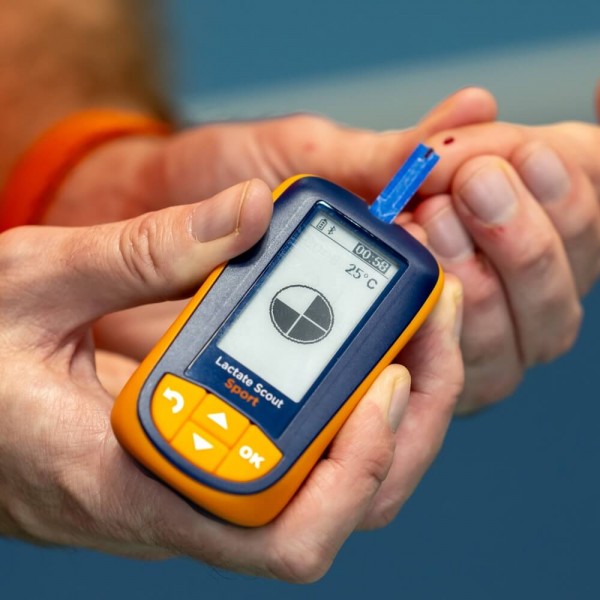EKF
EKF Lactate Scout Sport
EKF Lactate Scout Sport
Couldn't load pickup availability
Simple, accurate and reliable lactate analyzer for sports performance monitoring
Lactate Scout Sport is the number one choice for sports scientists and professional athletes globally. The Lactate Scout Sport is a simple and reliable lactate meter perfect for training outdoors, in the gym or for analysing performance in a laboratory.
The Lactate Scout Sport is designed for field and gym use and is ideal for both coaches and athletes to rapidly measure lactate levels. From this measurement it is possible to assess athlete endurance levels, devise optimum training programmes, avoid over-training and to use metabolic information to help set target heart rate zones.
The lactate strips require only 0.2 µl of capillary blood and provides results in 10 seconds. Lactate Scout Sport can store up to 500 results and also connects with Bluetooth® enabled heart rate monitors. It also features a stopwatch function to help analyse performance.
With an integrated step test function and Bluetooth® connectivity, the Lactate Scout Sport is one of the most advanced hand-held lactate analysers on the market.
The Lactate Scout Sport is a user-friendly tool. The e-paper display is easy to navigate and provides excellent readability in varying light conditions and at different viewing angles.
Lactate measurement in sports performance
During high-intensity exercise, the body produces lactate faster than it can be metabolised and removed from the blood stream. This leads to accumulation of lactate in the bloodstream.
Up to a certain threshold, the body can clear lactate at a rate at which, although there is an elevated concentration of lactate in the blood, the concentration does not impede muscle function.
Higher intensity exercise will lead to this threshold being passed, such that lactate production exceeds lactate clearance. The biochemical processes associated with increased lactate places muscle cells under stress. It is therefore important to determine the lactate threshold at which training is most effective.
A lactate analyser is therefore useful in fitness training and cardiovascular training, to help increase endurance without overtraining.
Lactate is a source of energy and is metabolised by muscle cells. The more efficiently lactate is metabolised the lower the blood lactate concentration will be during exercise. Additionally, excess lactate will be cleared from the circulation more rapidly during the post-exercise period.
Lac [blood] = Lac [produced] Lac [eliminated]
Endurance athletes should aim to achieve an elevated lactate equilibrium - a balance between the production and breakdown of lactate.
For training to achieve positive results and improve performance, it is therefore recommended to exercise at just below the anaerobic threshold.
Exercising at higher-intensity levels will result in exceeding the anaerobic threshold and cause a rapid increase in blood lactate concentration. This threshold varies from person to person, and an individual's threshold can be determined using a step test. In a step test, the intensity of training gradually increases at defined intervals, e.g. on a treadmill or exercise bike or in a field test. The blood lactate concentration is measured at the end of each interval and plotted against the load value on a chart. The resulting curve indicates the threshold value. The greater the intensity of the athlete’s exercise at their anaerobic threshold indicates a fitter athlete.
If a training programme is designed so that exercise occurs in the anaerobic threshold range, it can have a positive impact on the metabolism, increase muscle cell contractions, improve muscle cell repair, increase blood capillaries and improve cardiac function. The body then produces energy more efficiently, even when exercising at higher levels of intensity.
Lactate measurement for athletes
During high-intensity exercise, the body produces lactate faster than it can be metabolised and removed from the blood stream. This leads to accumulation of lactate in the bloodstream. Read more about lactate measurement for athletes.
Lactate analyzer specifications
- Easy to use
- Insert/remove strip to turn on/off
- Simplified navigation to enable flexibility whilst training
- Only 0.2 µl of capillary blood required
- Pre-calibrated strips
- Device calibrated by simple coding
- Lactate measurement value, date/time, measuring mode, temperature, heart rate and memory ID on a single display
- Automatic self-test
Fast and accurate
- Enzymatic amperometric detection method
- Results within 10 seconds
- Measuring range: 0.5 - 25 mmol/L
- Compensates for the influence of low and high hematocrit levels
- Imprecision:
- Hct-range 35 – 50% : 0.5 – 6.7 mmol/L blood lactate ≤0.2 mmol/L, 6.8 – 25 mmol/L blood lactate ≤3%
- Hct range 20 – <35% and >50%-70% : 0.5 – 7.5 mmol/L blood lactate ≤0,3 mmol/L, 7.6 – 25 mmol/L blood lactate ≤4%
- Check Solutions available for functional control
Practical and reliable
- Stores up to 500 results
- 1,000 tests using just 2 x CR2450 batteries
- Integrated Bluetooth® Low Energy connectivity
- Pocket-size: 91 mm (h) x 46 mm (w) x 21 mm (d)
- Lightweight: 60 g
- Operating range: 10-45 °C and max. 85 % humidity
Performance measurement
- Single and step-test measurements (resting/exercise/recreation)
- Connection to heart rate monitors compatible to Bluetooth® Low Energy for linking to lactate value
- Stopwatch function
- Lactate Scout Assistant software available for performance management
Lost in fueling? Book a complimentary Fueling Strategy Session with our performance nutrition specialist!
Don't forget to follow us on Instagram :-)






